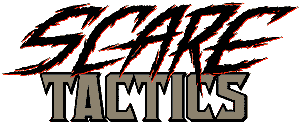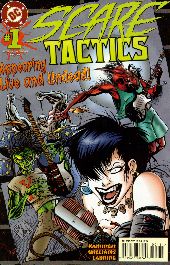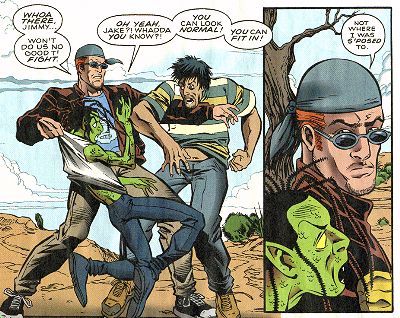Scare Tactics

 This title is one of four new DC-Universe series with a horror angle of one kind or another. They’ve been referred (with varying degrees of officiality) as “the Dark Side of the DCU”, “Weirdoverse”, and (because they don’t bear the “mature readers” rating) “Vertigo lite”.
This title is one of four new DC-Universe series with a horror angle of one kind or another. They’ve been referred (with varying degrees of officiality) as “the Dark Side of the DCU”, “Weirdoverse”, and (because they don’t bear the “mature readers” rating) “Vertigo lite”.
 The 10-page debut of the Scare Tactics crew in Showcase didn’t really impress me. It introduced the characters, but I didn’t really get the point of what it was about. The mixture of humour and horror (along with social commentary) was uneasy. It seemed to be taking the side of “outsiders who are misunderstood because they’re different”… by making fun of middle-of-nowhere hicks because they’re different. Kaminksi has explained in the Usenet discussion group rec.arts.comics.dc.universe that that wasn’t his point, but the story didn’t encourage me to pick up the series when it started. (Not even the note at the end promising that if I didn’t like it, they’d eat a bug.)
The 10-page debut of the Scare Tactics crew in Showcase didn’t really impress me. It introduced the characters, but I didn’t really get the point of what it was about. The mixture of humour and horror (along with social commentary) was uneasy. It seemed to be taking the side of “outsiders who are misunderstood because they’re different”… by making fun of middle-of-nowhere hicks because they’re different. Kaminksi has explained in the Usenet discussion group rec.arts.comics.dc.universe that that wasn’t his point, but the story didn’t encourage me to pick up the series when it started. (Not even the note at the end promising that if I didn’t like it, they’d eat a bug.)
The cover of Scare Tactics #1 didn’t entice me either, with its “Hey, we’re a wild rock and roll band!” theme. And since I don’t like to join stories “already in progress”, I automatically passed on the issues that followed.
But the series had some fans in r.a.c.dc.u, who praised it as one of the better new series to come down the line lately. One even exhorted people to read it, or else he’d beat them with a stick. So I picked up the back issues (still on the rack of my local shop), and gave them a read. {sigh} Now I have yet another series on my list to follow. (The comics industry may be in a commercial slump, but there’s still more worthwhile stuff out there than I have time for.)
The rock-and-roll-band schtick turned out to be mostly just a plot device to get the characters out of a jam in #1, and put them On The Road… an excuse for taking them from place to place (reminiscent of the Scooby Doo gang and their groovy van from Saturday morning cartoons when I was kid). I encourage Kaminski to ignore the band idea as much as he feels like it, and just go with the “misfits on the run” angle.
 The misfits themselves include a vampire chick, teenage werewolf, a dreadlocked lizard boy, and a dumb grey brute. They’re accompanied by an “ordinary” conspiracy theorist, who acts as their mentor. The monsters each have code names, but they’re not very memorable… or important. What’s important is the characters themselves. They have personalities that go beyond the cliches of their monster archetypes, including traits that make them very human. They aren’t just the latest in the line of Groovy Ghoulies, Drac Pack, etc.
The misfits themselves include a vampire chick, teenage werewolf, a dreadlocked lizard boy, and a dumb grey brute. They’re accompanied by an “ordinary” conspiracy theorist, who acts as their mentor. The monsters each have code names, but they’re not very memorable… or important. What’s important is the characters themselves. They have personalities that go beyond the cliches of their monster archetypes, including traits that make them very human. They aren’t just the latest in the line of Groovy Ghoulies, Drac Pack, etc.
One good trait the series does seem to share with it’s teenage-monster TV-show cousins is a fairly episodic nature. Each of the 5 issues so far has included a complete story, with a beginning, middle, and end. (Well, actually the beginning of each story is usually at the end of the preceding issue with a cliffhanger, but it’s pretty easy to start reading at page 1 of a given issue without being lost.) As much as I like complex, long-form
storytelling, it’s nice to be able to pick up an issue of a comic without “part X of Y” on the cover.
One tightrope Kaminski still has to walk is the one between humour, horror, and heart. For example, Nina is a bona fide bloodsucking vampire, which is hard to make jokes about without getting into some very dark humour, or to make her a sympathetic character without getting into maudlin gothic tragedy. So far it’s working, though. (I get a guilty pleasure chuckling at the way she refers to the living as “breathers”, which is just a bad accent away from the term some gay folk use for those whose heterosexuality predisposes them to breed.)
I make no promises about bug-eating because I can easily see that this isn’t a book for everyone. And I make no threats about stick-beating because it’s not fantabulous enough to warrant violence upon those who don’t support it. But I enjoy reading it. And isn’t that what comics are supposed to be about?
